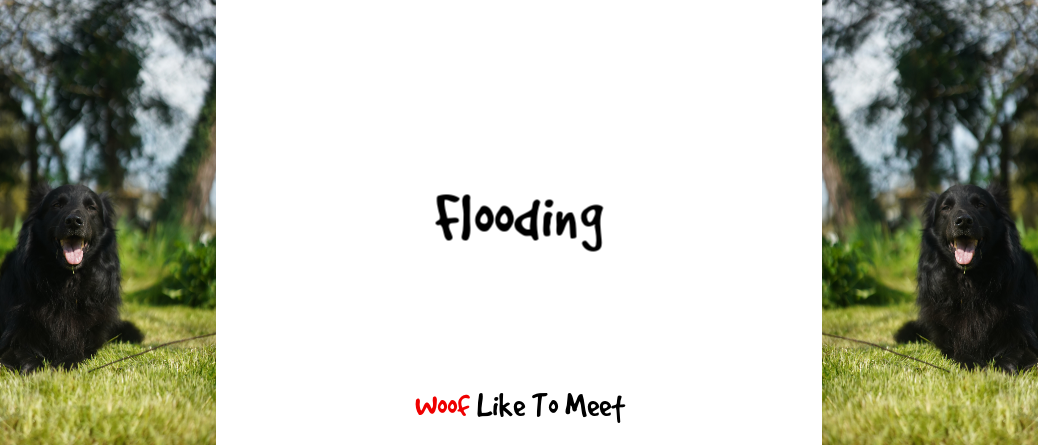
So in the last three posts, I’ve been looking at three key concepts for dog guardians: habituation, desensitisation and counterconditioning. Today I’m going to talk about flooding, which can be an accidental by-product of all three.
Let’s get into what flooding is exactly and make sure we’re all talking about the same thing. What do I mean when I talk about flooding? First, I want to talk about what it is and what it isn’t, and then we’ll consider the ethics and the fallout of it once we’re all clear on what flooding is in psychology.
Flooding is the deliberate exposure to inescapable negatively conditioned stimuli at a strength that elicits the full emotional response. So that’s a textbook definition.
First off, flooding is purposeful and deliberate. I do think there are accidental moments when we’re flooding our dogs, but I’ll come back to that distinction later. It’s also to things that the dog thinks are aversive, unpleasant, even frightening, painful or scary – that’s the negatively conditioned stimuli bit.
And it is also at full strength.
Let me just focus on that word inescapable, because it’s crucial. The dog cannot escape. Either they’re in a confined space or they’re trapped. They’re on a leash or behind a gate. It may also be inescapable without a confined space or being on a leash because of the caregiver bond. We sometimes use our dogs’ trust in us and put them in situations that they could escape from but they just don’t, because, well, it’s us.
There’s a bit of a myth in the dog training world that if you’re habituating a dog to an experience, or even if you’re desensitising them, then if you accidentally go over their threshold, you’re flooding them. Well, this may or may not be true: it depends on whether or not the dog can get away.
As soon as we enclose a dog in a space or we get the leashes out, though, we’re in potential flooding territory. Flooding is about removing choice. It’s about removing consent.
I’ve heard several voices in the dog training community discuss flooding in human terms, and you know I like to give you human examples. In this case, I can’t, as it would be completely unethical to deliberately expose someone to things they are afraid of. Now some therapies in the past, such as conversion therapies for homosexuality or aversion therapies have deliberately exposed someone to inescapable shock or nausea-inducing drugs paired up with homoerotic images in attempts to cure them. I think we’re a good 50 years into realising this is unacceptable. If I have a fear of spiders and your therapeutic solution is to lock me in a room with spiders until I get over it, you’re not creating a therapeutic setting, you’re creating something out of a dystopian work of fiction.
Whilst I’ve no doubt that some disreputable therapists may flood patients on purpose, you sign up for it (usually). So you can escape. You know it is going to happen and you consent. Even if that means you know it will be inescapable.
When we flood dogs, they do not consent. They do not know what is going to happen and they have no option to sign up or not.
So for kind of the first time in my life, I cannot make an analogy that you would understand because for the vast majority of us, we have no concept of a therapist forcing us against our will to face up to our fears in an inescapable situation.
We, as humans, mostly have no concept of what that is like. If it did happen to us, it would be abuse. Hands down. Both morally and legally. If a therapist seized you against your will or without your prior consent and deliberately exposed you to levels of things you found unpleasant at full strength, that’d probably be a prison sentence. That would definitely be a prison sentence if they did it to a child or to a vulnerable person.
This is why I can’t justify its use as a training method with animals.
Flooding is not just habituating a dog past their coping levels in the hopes that they’ll realise things are okay. It’s the inescapable element of it. So for instance, I watched one dog owner forcing her terrified dog around a local fair because a trainer had said the dog needed to get used to social events. Well, first, habituation does not involve flooding. Or it should not. But the dog was on a lead and clearly could not cope. And what happens when our sympathetic nervous system is engaged and we are unable to escape? There are lots of Fs, here: fight and flight being two of them. When we take away flight, we remove one of those options. But be aware that some dogs may fidget, may seem to be over-excited, may get over-friendly and may fool around. So for example, once, when I had to trap a stray dog to catch her and stop her getting squashed, first she tried flight until we removed that option. Then she got fidgety. Then she froze. Then she tried fighting. Working your way through all the remaining Fs is one thing dogs may do before they eventually give up.
Many, many dogs will try aggression in this circumstance. And they learn it can be really effective.
Flooding is not just about inescapable exposure, though, but exposure at full strength. No attempts are made to mitigate or soften the stimulus.
So having set out my stall, let me explain why I feel the way that I do and why flooding – whether purposeful or accidental – should be avoided at all costs. Also, please notice that I used “as an ‘education’ method”. That was purposeful.
We, as enlightened modern human beings who’ve never been subject to inescapable stimuli in a therapeutic setting, have very little understanding of what it’s like for an animal. We can understand habituation and desensitisation, counterconditioning and so on, because these are human therapies too. But we have no concept of flooding in educational or therapeutic settings, which is why we’re less aware of its fallout.
First, its fallout is learned helplessness. In the 60s and 70s, psychologist Martin Seligman used dogs to learn about why people don’t take help when it’s offered or why they don’t seem to be able to get themselves out of certain situations. In this case, it’s not admissible to say dogs don’t experience learned helplessness because they literally were the subject of the experiments Seligman conducted using inescapable shock.

Some dogs were placed in a sling like this one and subjected to inescapable shock. Others had a way to switch the shock off. Some were no shocked at all.
Then the dogs were placed in a shuttle box like the one below, and subjected to shock. Those who had previously learned there was no way to stop the shock did not even try to hop over the wall. They just gave in. Just by the by, some psychologists gloss over the fact that the shocks administered in the shuttlebox were enough to induce muscle seizure…. and still the dogs wouldn’t even try to escape.

That’s how being flooded works. You are subjected to inescapable aversives and you learn to shut down. It stops our problem solving and a lot of our other behaviours.
All reactions are muted. We stop reacting because we’ve learned we cannot escape. Thus to the untrained eye, it may seem like the dog is ‘coping’ when in reality, the dog has simply learned that there is no point trying to escape.
Honestly, flooded dogs are a nightmare. Especially those who’ve been purposely flooded by other dog trainers. It enrages me, quite honestly. One local trainer who held a dog down to be petted by strangers… 40 injurious bites later and the dog finally “submitted”. Another who repeatedly alpha rolled fearful dogs and demanded their euthanasia if not. Vets who don’t understand fear free handling. Groomers who think their ‘still’ dogs are a sign of calmness.
It’s the absolute antithesis of my work. Dogs who are flooded often lose all trust in their guardians and trainers, or in humans full stop. I can feel a lot of sympathy for guardians who have accidentally flooded their dog because they didn’t know better, haven’t seen their relationship as one of consent and choice rather than compliance, dominance and force. After all, our media has often been complicit in promoting these myths because they make good television. No wonder people believe in miracle cures and 30-minute turnarounds!
But what I can’t forgive are other professionals who do it. You’re basically stealing a living if you deliberately and wilfully use flooding with a dog. It is ethically worse for me than using punishers like shock or chokes because at least there, if they’re cued and the dog is clear about their use, then they can avoid the punisher. The whole purpose of flooding when done by trainers as an ‘education’ method is to subject dogs to such levels of inescapable aversives that they have no choice but to submit, perhaps having worked through the whole gamut of aggression first.
The problem comes when we consider the ethics – and this is where it gets complicated. Imagine I hit a stray dog by accident when driving my car. The dog is panicking and I use a blanket to stop them struggling and to put them in my car. If they didn’t like strangers or cars, what I’m doing is deliberately subjecting them to inescapable stimulus at full strength. Likewise, if I have to trap a dog who has been running loose for weeks, even if I use a humane trap and sedatives. The second is thankfully not frequent, but in working for the pound, it’s something I might have to do. I just can’t work to desensitise a dog to myself over weeks and weeks if the dog will starve in the meantime. So it depends. Sometimes we knowingly flood animals and we know that the damage we’re doing is likely to be significant. Likewise, for new arrivals in the shelter, there are times we flood the dog simply by cleaning their kennel or even by bringing them their food. These real life situations are not training, however, and hoping the dog will just “get over it” is like putting money on a coin toss – you just don’t know which way it will go.
Real life situations means we have no other choice other than leaving the dog to roam about or die of their injuries. It’s a knowing choice but one that I’m fully aware of the consequences and try to avoid wherever possible. But it’s not a method I’d choose if there were any other options available to me.
If you think that gives you free rein to use it as a training method, it doesn’t.
People get hit by buses, get struck by lightning or drown in swimming pools. I don’t include them in my teaching repertoire.
Just because something happens in real life does not make it a fit tool for use in teaching. Abuse happens in real life and perpetrators of domestic abuse use flooding on their victims. That’s real life. I don’t see those as educative situations, and I hope you don’t either.
We need to stop using this Appeal to Nature fallacy to say that just because it’s natural and it happens in real life, it must be okay. It isn’t. It wouldn’t be okay for a therapist to deliberately prevent you from escaping from something you’re afraid of,. It wouldn’t be okay for a therapist to do this to a pre-verbal child. It wouldn’t be okay for them to do it to a non-verbal adult. It’s not okay to do it with animals, either. Not as a training method.
This is why, when we use habituation, we need to be careful we don’t overdo it and tip-toe into flooding territory if our dogs are trapped by walls or a leash.
It’s why, when we use desensitisation, we need to make sure we’re in the “I know it’s there, but I’m coping” territory.
And likewise for counterconditioning.
The problem is that it can be very hard to know if your dog really is calm or whether they’re shut down, so you absolutely need a good understanding of canine body language to know the difference. Understanding stress signals is absolutely vital. Whenever you’re working within four walls or you have the dog on a leash, be mindful of the fact you may accidentally be flooding your dog even if that’s not what you intended.
So make sure you stick to the easy, the gentle, the minimal, especially if you’re working with a leash or indoors. Whilst I understand accidental flooding – I know I definitely did it by accident to Heston when I was new to the whole world of dogs – and Tilly’s sensitive bladder was a really good indicator that we’d pushed her over the edge – it’s something I should have been told about. Sadly, few people in animal training talk about it.
But, as Maya Angelou says, when we know better, we do better.
Let’s take purposeful flooding out of our repertoire and stop conning ourselves that “getting over it” is a valid reason to cause the complete suppression of behaviour. After all, our dogs are not okay. They’ve just learned not to show that they’re not okay.

